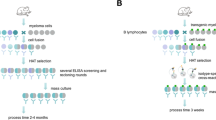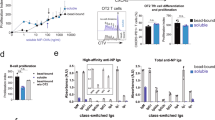Abstract
SINCE the identification of IgE antibodies as mediators of allergic reactions by Ishizaka et al.1 extensive work has been done to purify this new type of immunoglobulin from the serum of allergic patients and animals However, all attempts so far have been limited by the very low serum concentration of these reaginic antibodies This difficulty has been partly overcome with the detection of the extremely rarely occurring IgE-producing myelomas of the human2 and the rat3, although IgE myelomas of other species are lacking Moreover, none of the available IgE-myeloma proteins has a known allergenic specificity, which is indispensable for several important applications to future studies on the origin and mechanism of allergic processes Here we describe a new murine cell line which is continuously producing high amounts of IgE antibodies with anti-ovalbumin (OA) specificity This cell line was generated by cell fusion of murine myeloma cells with spleen cells from OA-hyperimmunised mice following the cell hybridisation technique developed by Köhler and Milstein4.
This is a preview of subscription content, access via your institution
Access options
Subscribe to this journal
Receive 51 print issues and online access
$199.00 per year
only $3.90 per issue
Buy this article
- Purchase on Springer Link
- Instant access to full article PDF
Prices may be subject to local taxes which are calculated during checkout
Similar content being viewed by others
References
Ishizaka, K., Ishizaka, T. & Hornbrook, M. M. J. Immun. 97, 75 (1966).
Johansson, S. G. O. & Bennich, H. Immunology 13, 381 (1967).
Bazin, H., Beckers, A. & Deckers, Ch. J. natn. Cancer Inst. 51, 1359 (1973).
Köhler, G. & Milstein, C. Nature 256, 495 (1975).
Kulczycki, A., Isersky, C. & Metzger, H. J. exp. Med. 139, 600 (1974).
Hämmerlimg, G. J. Eur. J. Immun. 7, 743 (1977).
Littlefield, J. W. Science 145, 709 (1964).
Ovary, Z. in Immunological Methods (ed Ackroyd, J. F.) 259 (Blackwell, Oxford, 1964).
Prouvost-Danon, A., Binaghi, R. A. & Abadie, A. Immunochemistry 14, 81 (1977).
Ouchterlony, O. Acta path. Microbiol. Scand. 26, 507 (1949).
Spector, W. G. Pharmac. Rev. 10, 475 (1958).
Spicer, B. A., Ross, J. W. & Smith, H. Clin. exp. Immun. 21, 419 (1975).
Lehrer, S. B. Immunochemistry 13, 837 (1976).
Shore, P. A., Burkhalter, A. & Cohn, V. J. Pharmac. exp. Ther. 127, 182 (1959).
Author information
Authors and Affiliations
Rights and permissions
About this article
Cite this article
BÖTTCHER, I., HÄMMERLING, G. & KAPP, JF. Continuous production of monoclonal mouse IgE antibodies with known allergenic specificity by a hybrid cell line. Nature 275, 761–762 (1978). https://doi.org/10.1038/275761a0
Received:
Accepted:
Issue Date:
DOI: https://doi.org/10.1038/275761a0
This article is cited by
-
Photo-immunotargeting with haematoporphyrin conjugates activated by a low-power He-Ne laser
Cancer Immunology Immunotherapy (1992)
-
Biological effect of low-power helium-neon (HeNe) laser irradiation
Lasers in Medical Science (1988)
-
Differential release of serotonin and histamine from mast cells
Nature (1982)
-
Allelic polymorphism of murine IgE controlled by the seventh immunoglobulin heavy chain allotype locus
Immunogenetics (1981)
Comments
By submitting a comment you agree to abide by our Terms and Community Guidelines. If you find something abusive or that does not comply with our terms or guidelines please flag it as inappropriate.



